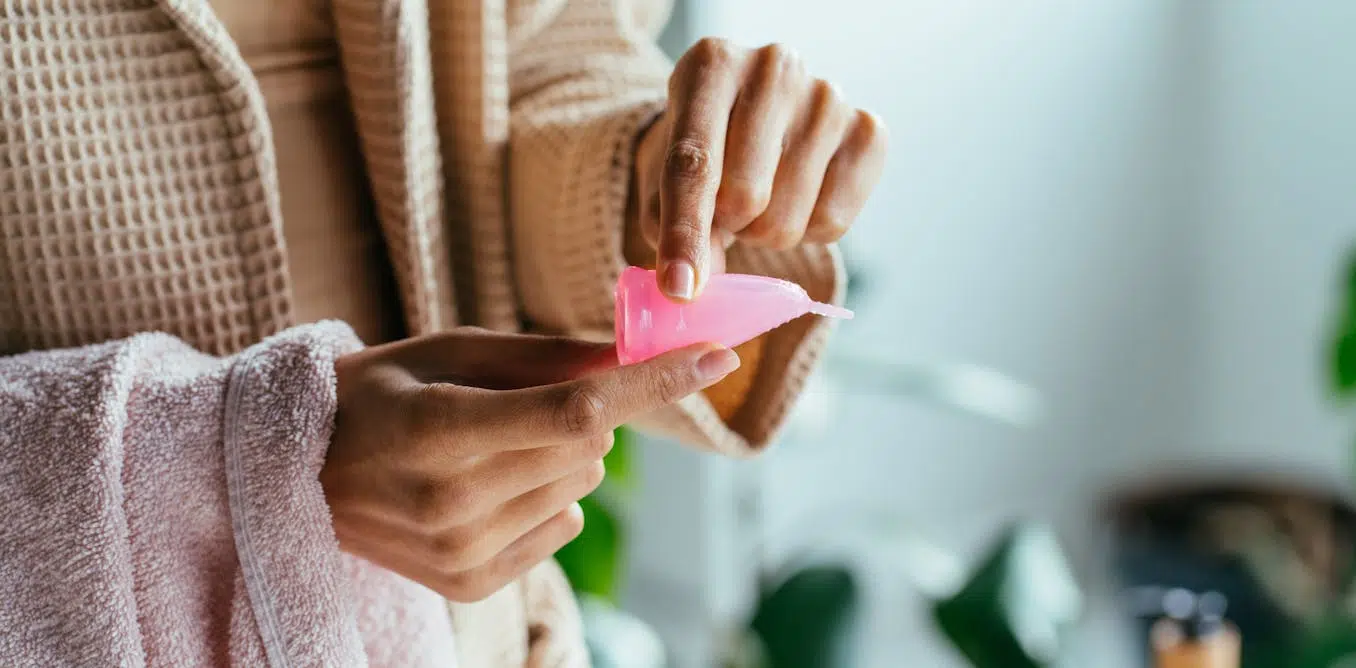Menstrual cups are safe and sustainable – but they can be tricky for first-time users


We wanted to know what young people thought of menstrual cups
My colleagues and I surveyed 530 young people living in Australia between the ages of 15 and 24 who had ever tried using a menstrual cup. To find participants we used the menstrual cycle tracking app Clue. Clue users received a pop-up message when they opened the app inviting them to join the study.
Using Clue meant we could reach a large group of young people. It also avoided the risk of our survey being shared to networks online that might be more biased, such as groups advocating for the use of cups. At the same time, we relied on volunteers. We know more of our participants were from cities and wealthier areas than average. And it’s possible those who had more negative or positive experiences were motivated to complete the survey.
Pain, leaks and cups getting stuck
Lots of young people had difficulties with menstrual cups, particularly the first time they used them. During the first period participants used a menstrual cup:
- only 10% successfully inserted their cup on the first try
- more than half (54%) reported the cup leaked
- one in four (25%) reported pain or discomfort when the cup was in place
- 45% could not get the menstrual cup out on their first attempt, with 17% reporting they needed help to remove it
- 12 young people (2%) reported their IUD was displaced (IUDs are small contraceptive devices inserted into the uterus).
Participants described these difficulties as distressing. One said:
I kept being told the cup was a one size fits all and I really hurt myself trying to fit it in all the time and feeling anxiety that I was different somehow.
A learning curve
Experiences got better for those who kept using a menstrual cup. By the time they had used a cup for more than six cycles, 40% of young people reported no issues.
Of participants who kept using a cup, 48% felt confident after one to three cycles, and another 21% after four to six cycles. As one explained:
The first time trying to pull it out was scary because the grip is very different to a tampon. Feel like it is stuck and you won’t ever get it out […] all my friends have had the same first scary experience but then afterwards it’s fine!
Education is important
We found many young people didn’t know enough about how to choose or use a menstrual cup.
Just 19% of young people strongly agreed when we asked whether they had enough information to make an informed choice about which menstrual cup to buy. Less than half (44%) knew different menstrual cups had different characteristics (such as different sizes, firmness, and that different ones are designed for different cervix heights).
We need better information on how young people can find the right cup fit more easily. Online resources such as the website “Put A Cup In It” aim to provide comparisons across cups to inform users.
Conclusion
Our findings highlight the need for better education and support for young people who are using menstrual cups. Providing realistic information about the learning curve and potential discomforts when starting out can help young people feel prepared and make informed product choices. Comprehensive menstrual health education should start in our schools, empowering young people with the knowledge to make informed choices about their bodies.
FAQs
Q: How did you recruit participants for the study?
A: We used the menstrual cycle tracking app Clue to recruit participants. Clue users received a pop-up message when they opened the app inviting them to join the study.
Q: What was the most common difficulty participants reported when using a menstrual cup?
A: The most common difficulties reported were pain, leaks, and cups getting stuck. During the first period participants used a menstrual cup, 54% reported the cup leaked, and one in four (25%) reported pain or discomfort when the cup was in place.
Q: Did the participants who kept using a menstrual cup experience any improvements over time?
A: Yes, experiences got better for those who kept using a menstrual cup. By the time they had used a cup for more than six cycles, 40% of young people reported no issues.
Q: What do you recommend for young people who are considering using a menstrual cup?
A: We recommend that young people do their research and choose a menstrual cup that is right for them. They should also be prepared for a learning curve and potential discomforts when starting out. Online resources such as the website “Put A Cup In It” can provide helpful information and comparisons across cups to inform users.
Recent Posts
2025 Sampson Showdown Pro Wellness Show
2025 Sampson Showdown Pro Roster The 2025 Sampson Showdown Pro is scheduled for Saturday, March…
7 Common Causes of Pulmonary Arterial Hypertension
Pulmonary Arterial Hypertension (PAH): Causes and Types 1. Idiopathic PAH About half of PAH cases…
Losing your job is bad for your health, but there are things you can do to minimize the harm
Pathway to Illness When people lose their jobs, they do have real problems. Typically, for…
Coffee enemas probably won’t detox your system – they’re more likely to cause you serious damage
What do King Charles and Gwyneth Paltrow have in common? They've both at one point…
2025 China DMS Pro Bodybuilding Show
2025 China DMS Pro: A Look Ahead China's First Show of the 2025 Bodybuilding Season…
Sara Davies reveals how she dropped three dress sizes and admits her weight loss
Sara Davies Reveals How She Dropped Three Dress Sizes and Why She Will Never Be…


